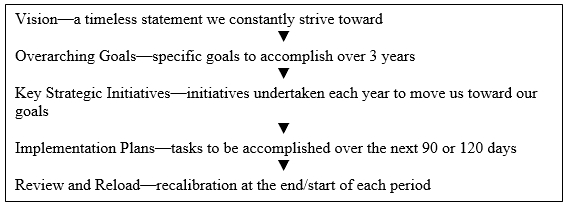Let’s review the diminishing timeline associated with our strategic planning process.
Last month, we introduced the Key Strategies the Board adopted at its fall meeting in September 2017. They break down our three-year goals into increasingly smaller pieces that are manageable. The Key Strategic Initiatives define what must be accomplished in the next year, by the fall of 2018.

The Implementation Plan is a tool we rely upon to break these annual Key Strategies into increasingly smaller tasks that must be completed over the next 90 days (or 120 days in the case of the Board). The concept is simple. When we are successful with the bite-size tasks agreed upon for the next 90 days, we’ll move closer to the year-end Definitions of Success we established for each our Key Strategies. And when we accomplish our Key Strategic Initiatives for the year, we will have moved one step closer to accomplishing our three-year Overarching Goals.
 The Implementation Plan involves a series of spreadsheets built within an Excel workbook. Each tab in the workbook includes the Implementation Plan for a 90 (or 120) day cycle. Each spreadsheet has six columns, with one column used for each Key Strategy (see accompanying figure). The title and brief description of the Key Strategy appears in the header for each column. Each header is followed by five task cells that constitute the Plan of Action for a given cycle.
The Implementation Plan involves a series of spreadsheets built within an Excel workbook. Each tab in the workbook includes the Implementation Plan for a 90 (or 120) day cycle. Each spreadsheet has six columns, with one column used for each Key Strategy (see accompanying figure). The title and brief description of the Key Strategy appears in the header for each column. Each header is followed by five task cells that constitute the Plan of Action for a given cycle.
For each column, specific tasks that must be initiated and/or completed during the upcoming cycle are described. Accomplishing these tasks moves us toward success.
After the Plan of Action section is completed (for all Key Strategies), it is time to step back and assess the overall plan for reasonableness. Remember the expression, “If everything is important, nothing is!” The final litmus test is simple—the Plan of Action for all Key Strategies must be achievable—that is, the task must be completed or at a minimum, work must be initiated, within the next cycle of 90 (or 120) days.
An “Owner” volunteers to oversee all aspects of implementation, and schedules calls or meetings with team members. Each task should also have the initials of the owner of that specific task. In this manner, the key strategy team develops the plan of action for the next 90 days. Each task has a leader, and the overall key strategy has an owner who helps to ensure success.
In the next issue, we will explore the Review & Reload process that occurs at the end of each cycle to keep the plan alive.
Note: This article is maintained as part of an ongoing series of posts on the NACE web site.